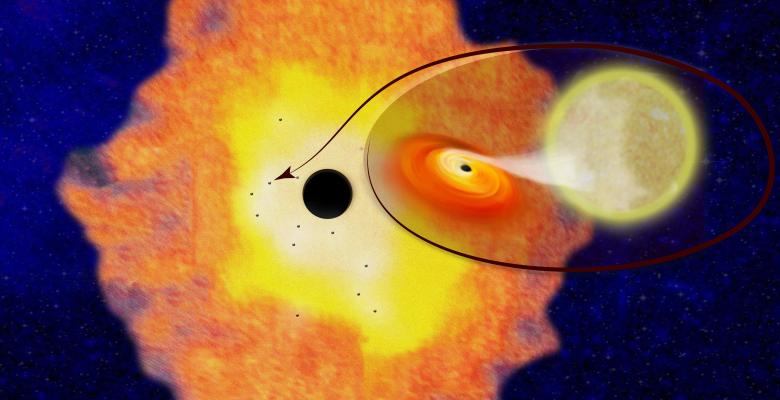Around the supermassive black hole in the center of the Milky Way - about 10,000 small black holes

Image of the center of the Galaxy obtained by the Chandra Observatory with indication of thermal and nonthermal sources of X-ray radiation in the power range from 2 keV to 8 keV
According to the fundamental prediction of galactic stellar dynamics, black holes should shift to the center of the galaxy and accumulate there. But to date, astrophysicists have not had actual evidence that this process really occurs in our Milky Way. The lack of evidence of this kind is a bit confusing, given the scale of the phenomenon.
Scientists from Columbia University (USA) with colleagues from the Space Science Institute (Colorado) and the Harvard-Smithsonian Center for Astrophysics (Massachusetts) decided to fill this gap - and spenta large-scale study on the search for black holes near the center of our galaxy according to the data of the Chandra space x-ray observatory . Over the past 12 years, Chandra has accumulated 1.4 × 10 6 observations of the center of the Galaxy using the Advanced CCD Imaging Spectrometer I (ACIS-I) spectrometer.
Considering the very large number of X-ray sources in the center of the Milky Way, such as the radio source Sagittarius A (Sagittarius A, supermassive black hole) and IRS 13, as well as hot gas emissions, the scientists limited their analysis to an area that is not closer than 5 ″ from Strelets And that corresponds to the projection distance of about 0.2 parsec. In the illustration above, the inner and outer boundaries of the observation area are indicated by yellow circles. The inner boundary corresponds to the projection distance of 0.2 pc from the center (8 thousand pc), and the outer boundary - 1 pc. The violet ellipse (7.8 × 3.9 pc) denotes the boundaries of the hard x-ray radiation recorded by the NuSTAR telescope due to the thermal emission of intermediate polar. Thermal and non-thermal sources of radiation on the map are indicated by red and blue circles. As you can see, non-thermal radio sources are concentrated mainly between two yellow circles. A total of 415 radio sources were found in the region between 0.2 and 3.8 pc in the power range from 2 keV to 8 keV. After filtering, 92 sources remain, of which 26 are at a projection distance closer than 1 parsec to the center.
It is known that the "non-extreme" nature of radiation is characteristic of binary systems with black holes, neutron stars and pulsars.
Solitary black holes are almost impossible to detect. But if a black hole has a companion in the form of a neutron star, then such a system gives out itself on the characteristic radiation. After analyzing all the collected data, the researchers found in the specified region with a radius of about three light years from the center of the Milky Way twelve such binary systems with a black hole.

In general, black hole binary systems are a rare occurrence. Finding such a large number of such systems in such a small area means that the concentration of black holes in the center of the Milky Way is many orders of magnitude greater than in other regions, which fully complies with the prediction of galactic stellar dynamics. For comparison, in all of our galaxy with a diameter of about 100,000 light years, only five black holes were discovered. And here, on a small patch in three light years - 12 double systems with black holes at once.

According to the current theory of black holes, given the likelihood of the formation of binary systems compared to conventional BHs, scientists estimated the total number of BHs in the region of research. The presence of 12 binary systems with BH means that there are about 10,000 black holes in total.
The authors of the study suggest that the availability of information on the number and concentration of black holes will make it possible to compile the best predictive models for BH merging with the formation of gravitational waves that reach the Earth. Scientists have only recently begun to register the spread of these folds of space-time, predicted by Einstein about a century ago.
The scientific article was published on April 5, 2018 in the journal Nature (doi: 10.1038 / nature25029, pdf ).
